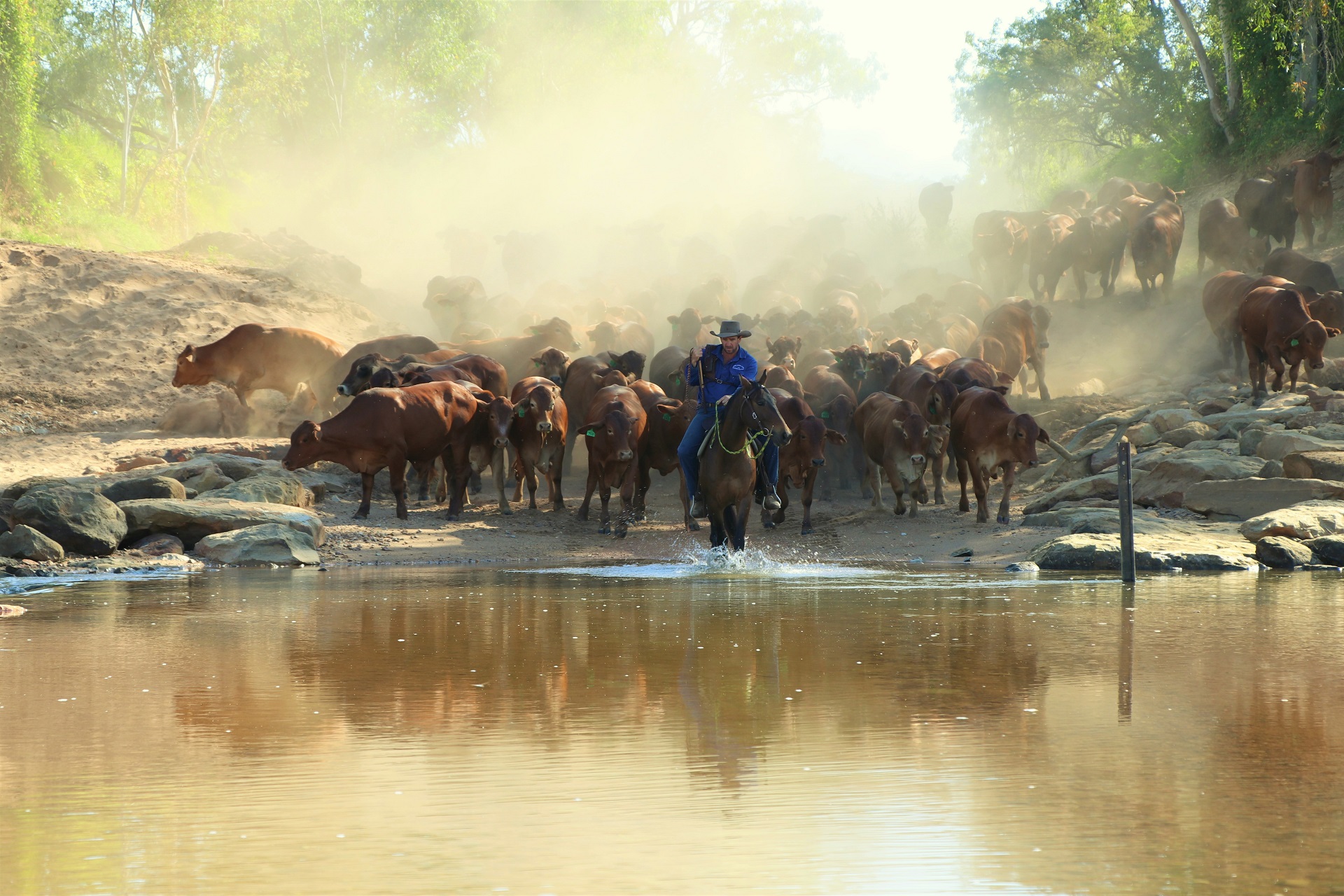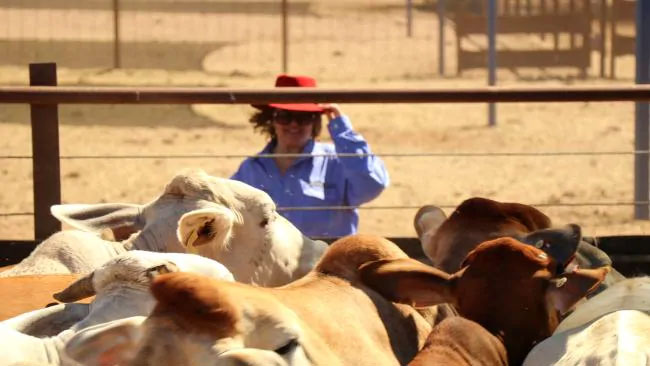27 May 2017
Sarah-Jane Tasker
The Australian
Gina Rinehart is covered in red dust — it’s filling her eyes and stubbornly settling on her face — as she inspects cattle at her top Northern Territory station, and despite the sun sitting high in the sky and a strong wind blowing desert dirt all over the Australian billionaire, she is smiling. Rinehart is fresh from a recent Kidman board meeting in Shanghai, with promises of further investment in new farming technologies, when The Weekend Australian joined her this week for a tour of Helen Springs station, the prized property in the Kidman portfolio.
Her passion for the land, born from a childhood spent on remote stations in the north of Western Australia, is on display as she plays tour guide of the remote property, about 140km north of Tennant Creek.
The softly-spoken Rinehart is in good spirits the night before touring the station, laughing with staff about an “in-joke” they all share and freely telling stories of recent travel. She is relaxed and excited about the potential to build on her cattle plans.
Helen Springs, the jewel in the crown of the Kidman properties, is a picture-perfect location for Rinehart to share her vision for her cattle empire. The homestead is an oasis in the desert, with a sprawling garden, filled with a variety of fruit trees — lemon, grapefruit and coconut palms — and pink roses in bloom.
Viewing the vast station from the air on the day of the tour, Rinehart’s sharp eye is scanning the land from the helicopter window, as she points out to the station manager she wants to see more shade for the animals. It soon becomes apparent the billionaire is a soft touch when it comes to the animals and is determined to ensure they have appropriate shade at watering holes and stockyards. “We want to shade the stockyards because we want to, not because we have to,” she says.
Rinehart is across every detail about the station and her wider cattle interests and she is confident the changes they are set to implement will lead the industry.
The country’s new “cattle queen” has ambitious plans to roll out state-of-the-art technology across the Kidman portfolio.
Australia’s third-richest person, with an estimated wealth of $10.41 billion, purchased the country’s largest pastoral portfolio, S. Kidman & Co, with Chinese joint venture partner Shanghai CRED, late last year. Her company, Hancock Prospecting, is the majority owner with a 67 per cent stake in the cattle company.
The $386.5m Kidman acquisition added 10 cattle stations, making up about 1.3 per cent of Australia’s total land area, to Rinehart’s agricultural portfolio. Following that acquisition Hancock became one of the top three beef producers in the country with a herd of about 300,000 cattle and it sells about 150,000 head a year.
Rinehart says her Chinese partners backed her early plan to forgo profits in the initial stages and leave the money in Australia to reinvest in the business.
“Every time we have presented a budget to our partners they have said yes,” she says. “They understand our desire to invest in, and improve, the properties.
“They are so proud to be part of an iconic company … it’s not just Australians who know about this deal, it’s also talked about in China. There is a responsibility and duty on the Chinese partners to show this joint venture can perform — China is watching.”
The board has already approved tens of millions of dollars in investment in its first two board meetings. Rinehart recalls that she was slightly nervous ahead of the first board meeting in February, knowing she was about to ask the Chinese to forgo early profits.
“Here we are saying you’ve just paid a fortune to get into these properties but by the way we don’t want you to take any profit, so I thought it might be a difficult board meeting and was a little nervous,” she says.
“By the time we got to the second meeting, we were asking for more budget approvals but he (Shanghai CRED principal Gui Guojie) is so supportive.”
The Weekend Australian understands that the board has approved a strategy to increase boxed beef and develop a branded product for the Kidman properties, with both a grain-fed and a grass-fed variety. That plan will expand the volume of boxed beef the company processes in South Australia and potentially Queensland.
Rinehart didn’t comment on reports that Hancock is preparing to sign a deal to export live cattle to China but the company is believed to be looking to eventually increase its live cattle exports after it increases its boxed beef product.
The plan to increase the herd is being supported by innovative technologies to be introduced to the Kidman properties.
The West Australian, whose company claims to be the country’s largest private taxpayer, having paid more than $3bn in taxes since 2011, says that more than 60 years ago her father, Lang Hancock, was using solar panels on his stations and had also introduced aerial mustering. She says he would be supportive of the new technologies and would be an early adopter.
Talking fondly of her father, Rinehart recalls her days as a child on her family stations and helping her dad when he was fixing the windmills. She says it was her role to lay out the tools and bring him the correct one when he yelled for it, climbing up and down the steep ladder each time.
Rinehart is also keen for the Kidman station managers to have access to helicopters. She overturned a previous Kidman rule that station managers couldn’t get a pilot’s licence and is actively encouraging managers who want to get a licence. Board approval has been given to pay for training and supply the helicopters.
“There was a policy in Kidman that managers weren’t allowed to fly, which was one of the first things we changed,” she says.
“We believe it gives managers a greater opportunity to know their station — they have to make so many decisions, it’s best they know their stations.”
The use of drones is another initiative Rinehart is excited about, having successfully trialled the program on a Hancock station in the Kimberley.
Chris Morrow, station manager at the Kimberley property, was flown to Shanghai recently to present the drone trial to the Kidman board.
He explains that one of the drones used has a wingspan of 2.5m and can be used to a radius of 40km, at a speed of 60km/h, with a carrying capacity of 4kg.
“The board were excited and my young team are also excited about new technology and what we can use the drones for,” he tells The Weekend Australian.
“It will make our operation more efficient than spending all day looking at things — we can send a drone out first and then target jobs.” Rinehart says that at the recent board meeting, Gui was rushing her through as he had another meeting to attend, but he was happy to slow it down when it came to the drones.
“He rushed us through the finances in record time but for the drone presentation I wasn’t getting told to hurry up,” she says.
“When it was time for Chris to give the presentation, Mr Gui was really animated.”
The young staff at Helen Springs are also excited about the possibilities technology will bring. The night Rinehart was arriving, the station staff shared with The Weekend Australian stories of their experience on the property with clear excitement about what the future holds.
As one station hand says: “Helen Springs is the station you want to work on, it’s one of the best.”
Peter Raleigh, the station manager at the neighbouring Bunchilly station, has a predominantly young staff, who he says are supportive of innovative technology and crave the changes coming through the industry.
“It’s exciting times for the company and as an industry as a whole. It’s a good time to be part of it all.”


